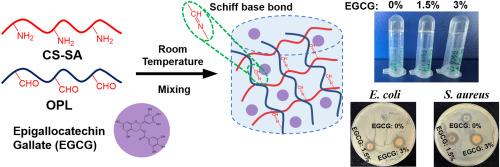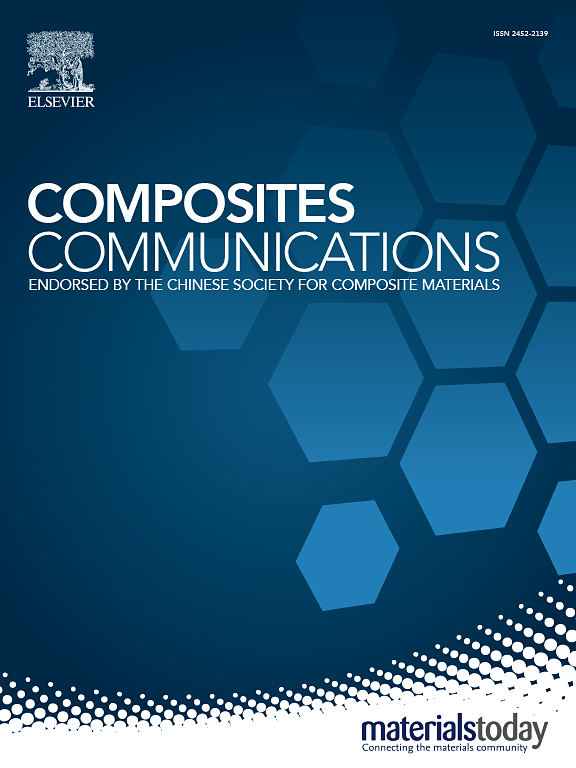使用添加了表没食子儿茶素没食子酸酯的壳聚糖和氧化拉普兰的壳聚糖和氧化拉普兰水凝胶敷料,实现自愈合、粘合、抗菌和生物相容性
IF 6.5
2区 材料科学
Q1 MATERIALS SCIENCE, COMPOSITES
引用次数: 0
摘要
开发创新的治疗策略是伤口再生的迫切需要。在这项研究中,壳聚糖(CS-SA)通过希夫碱链接与氧化拉普兰(OPL)反应,获得了功能性 CS-SA/OPL 水凝胶,并在其中原位加入了多酚表没食子儿茶素没食子酸酯(EGCG)。制备的水凝胶具有相互连接的多孔结构和良好的吸水能力(超过 37 g/g)。此外,CS-SA/OPL 水凝胶还具有优异的自愈合和粘合性能。加入 EGCG 后,CS-SA/OPL 水凝胶对大肠杆菌和金黄色葡萄球菌的抗菌效果以及抗氧化活性都得到了显著提高。此外,体外 L-929 细胞实验证实,在 CS-SA/OPL 水凝胶中加入 EGCG 后,细胞存活率和细胞迁移率均有明显提高。基于上述结果,水凝胶在伤口愈合应用中作为伤口敷料具有广阔的前景。本文章由计算机程序翻译,如有差异,请以英文原文为准。

Self-healing, adhesive, antibacterial, and biocompatible hydrogel dressings using sialic acid substituted chitosan and oxidized pullulan with incorporation of epigallocatechin gallate
The development of innovative therapeutic strategies is highly desired for wound regeneration. In this study, sialic acid substituted chitosan (CS-SA) was reacted with oxidized pullulan (OPL) via Schiff base links to obtain functional CS-SA/OPL hydrogels, into which the polyphenol epigallocatechin gallate (EGCG) was in situ incorporated. The prepared hydrogels exhibited interconnected porous structure and good water absorption ability (over 37 g/g). Furthermore, the CS-SA/OPL hydrogels performed excellent self-healing and adhesive properties. With the incorporation of EGCG, the antibacterial effects against E. coli and S. aureus, as well as antioxidative activity, were significantly improved. In addition, in vitro L-929 cell experiments confirmed that cell viability and cell immigration could be significantly improved with the incorporation of EGCG in CS-SA/OPL hydrogels. Based on the above results, hydrogels possess a promising potential as wound dressings in wound healing applications.
求助全文
通过发布文献求助,成功后即可免费获取论文全文。
去求助
来源期刊

Composites Communications
Materials Science-Ceramics and Composites
CiteScore
12.10
自引率
10.00%
发文量
340
审稿时长
36 days
期刊介绍:
Composites Communications (Compos. Commun.) is a peer-reviewed journal publishing short communications and letters on the latest advances in composites science and technology. With a rapid review and publication process, its goal is to disseminate new knowledge promptly within the composites community. The journal welcomes manuscripts presenting creative concepts and new findings in design, state-of-the-art approaches in processing, synthesis, characterization, and mechanics modeling. In addition to traditional fiber-/particulate-reinforced engineering composites, it encourages submissions on composites with exceptional physical, mechanical, and fracture properties, as well as those with unique functions and significant application potential. This includes biomimetic and bio-inspired composites for biomedical applications, functional nano-composites for thermal management and energy applications, and composites designed for extreme service environments.
 求助内容:
求助内容: 应助结果提醒方式:
应助结果提醒方式:


